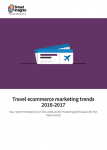Mobile is radically re-shaping the travel industry
The future of the travel industry is in customers’ hands — at their fingertips, to be exact. With a few apps, some swipes and clicks, and one-on-one conversations with big brands through social media, an entire travel experience will be planned and confirmed by the customer alone.
That’s a complete transformation from how it used to be. Not too long ago, if someone got the itch to visit an exotic location — or his grandmother in another state/country — he would pick up the phone and dial a travel agent. The expert on the other end of the line would then go to work conducting research and collecting brochures.
Fast-forward 10 years, and most travel agencies have closed shop, their agents succumbing to other lines of work. The world of travel has shifted from a human agent-dominated sales channel to a web-driven model where online travel agencies have largely supplanted traditional agents and, more often, suppliers communicate directly with consumers.
Digital marketers have led this online evolution with fresh ways to draw more guests to travel services. New ad formats with immersive experiences and compelling messaging have built strong brands over time. These ads, supported by a competitive market and highly tactical promotions, have driven the business of perishable travel products in an entirely new direction.
The Shift in Power
The move toward a web-driven model has put the power in the hands of the customer. Price comparisons on sites like KAYAK and perishable inventory sales through Travelzoo have increased the worth of sightseers’ dollars and given them the confidence to make informed decisions by themselves.
FlyerTalk, TripAdvisor, and SeatGuru have empowered consumers to shop for the specific experience they desire. Travelers can even customize their travel plans by purchasing seats with extra legroom and choosing airlines based on luggage charges or food for sale.
Rather than waiting for the professional to get back to them, vacationers now control the experience they’re planning and get the firsthand thrill of securing a great deal. This power mitigates potential disappointment and creates a strong pull for satisfied customers to share their excitement or positive experience online.
But how can travel marketers continue to leverage this power shift for their own brands?
An Experience Worth Sharing
Capturing and sharing content created by vacationers creates a dynamic real-time experience for those watching and reading online. Capitalizing on sightseers’ shared experiences is the most influential form of advertising currently available to digital marketers — one they should take advantage of.
When travelers have a great experience, they talk about it. More than ever, travel marketers can benefit from strategies that are informed by word of mouth. By putting tools in consumers’ hands, travel fanatics — sharing their adventures with other travel fanatics — are organically promoting the travel products, services, brands, and even specific people who have delivered the experience they so enjoyed.
Marriott Hotels & Resorts recently partnered with GoPro to take advantage of the personal escapades of its hotel guests. Guests in 18 of its Caribbean and Latin American resorts can now check out video cameras to capture memories throughout their vacations.
Vacationers are then encouraged to upload their footage to Instagram and Facebook using the hashtag #TravelBrilliantly, giving Marriott free and shareable advertising to attract potential customers all over the globe. The partnership with GoPro not only gives Marriott the ability to easily collect footage, but it also brands the hotel chain as part of the adventure niche.
Marriott has also jumped headfirst into the content marketing space with a popular online travel magazine, a short film, and even a TV series. “We say we’re going to own the travel lifestyle space like Red Bull owns action sports. We just happen to sell hotel rooms,” said David Beebe, Marriott’s vice president of global creative and content marketing.
The Ability to Solve Problems
When travelers are disappointed or need something, they also want to talk about it. With the social media tools now available, digital marketers can react to subpar customer service issues and solve problems in real time.
Because of social media’s response speed, both Qantas and KLM Royal Dutch Airlines use Twitter, Instagram, and other platforms to actively engage with customers. With the help of software, digital marketers can check for content posted from their on-site lounges, monitor messages sent to them (or posted about them), and respond in real time.
At Qantas, if a customer posts a photo to Instagram from one of its airport lounges, the customer care team is alerted immediately. Staff members then have a chance to resolve any issues.
KLM uses feedback from social media channels to enhance customer service. Suggestions from its online consumers have prompted the company to create destination guides based on crew members’ favorite locations, and it now allows those who aren’t passengers to purchase gifts and services for those traveling on the airline.
An Opportunity to Anticipate Needs
Picture a scenario in which a sudden surge of social media content related to canceled flights at Chicago O’Hare International Airport prompts hoteliers to act. Using the tools at their fingertips, they respond proactively by messaging travelers with last-minute savings on nearby room rates.
Likewise, car rental agencies could promote their one-way rental inventory and rates. These opportunities meet the needs of the market in real time — not simply to sell more product, but to also be there when customers need them. Utility is the frontier of travel marketing.
Moving forward, digital media experts will continue to push marketing into even more useful arenas, and customers will feel like advertising is a benefit, not a hindrance. Travel brands will meet customers in their moments of need with an empathetic message or offer, informed by better data and delivered via savvy media management.
Real-time insights like these — combined with programmatic media buying and a dynamic creative presence — can deliver a compelling message in ways marketers had once thought were a mere dream. Digital media has already transformed the travel industry, and the future of the market is only an imagination away.
source http://www.smartinsights.com/mobile-marketing/the-future-of-the-travel-industry-puts-customers-in-the-drivers-seat/


 Thanks to
Thanks to
No comments:
Post a Comment